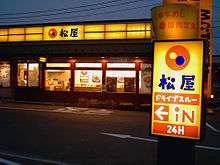Gyūdon
| Wikibooks Cookbook has a recipe/module on |
 Gyūdon from a Yoshinoya restaurant | |
| Alternative names | beef bowl |
|---|---|
| Place of origin | Japan |
| Main ingredients | rice, beef and onion |
Gyūdon (牛丼), literally beef bowl, is a Japanese dish consisting of a bowl of rice topped with beef and onion simmered in a mildly sweet sauce flavored with dashi (fish and seaweed stock), soy sauce and mirin (sweet rice wine). It sometimes also includes shirataki noodles, and is sometimes topped with a raw egg or a soft poached egg (onsen tamago). A very popular food in Japan, it is commonly served with beni shōga (pickled ginger), shichimi (ground chili pepper), and a side dish of miso soup. Gyū is the Chinese letter for cow, and don is short for donburi, the Japanese word for "bowl".
History

Due to the Meiji Restoration and subsequent westernization, western customs like eating beef were adopted and spread throughout Japan.
Gyūdon is considered to have come from Sukiyaki-don and the old dish gyūnabe, where thin slices of beef are cooked with vegetables in a pot, and at some point was put over rice and served in a bowl.
In 1862, the Kantō region's version of gyūnabe became the first popular version of this dish. In 1899 Eikichi Matsuda opened the first Yoshinoya restaurant, at the fish market in Tokyo's Nihonbashi district.
From the Taishō era (1912~) until the early Shōwa era (1926~), the use of cheap beef and the popularity of food sold from carts outdoors (yatai) in places like Asakusa boosted the popularity of the dish.
Although traces of the traditional sukiyaki can be found in some gyūdon containing ingredients such as konjac, grilled tofu, and green onions, most major food chains serve it as beef with onion.
Fast food


Gyūdon can be found in many restaurants in Japan and some fast food chains specialize exclusively in the dish. The largest gyūdon chain in Japan is Sukiya. Other large chains are Yoshinoya and Matsuya. Matsuya sells gyūdon under the name gyūmeshi (牛めし).
Some gyūdon chains charge for miso soup, but many of them serve complimentary miso soup for customers who are eating in. The major gyūdon restaurant chain that offers free miso soup is Matsuya, whereas other major chains like Sukiya offer it as a part of a set or combo.
Customer specifications
There are chains that allow customers to specify how their gyūdon is served with code phrases like tsuyudaku (extra tsuyu broth) at no extra charge. However, this service is only for people eating in confines of the restaurant.
Tsuyudaku, in regards to gyūdon, is jargon that refers to one kind of specification where the juice and tsuyu mixture is served in large amounts. Tsuyunuki is where the amount of tsuyu is specified to be less than usual. Also, the term tsuyudakudaku is code for a larger amount of tsuyu.
Sometimes, as with tsuyudakudakudaku ("dripping with soupiness"), people will request that the daku, or amount of tsuyu, be exceedingly increased.
There's a theory that says daku comes from the taku part of takusan (eng: many / a lot) which, when doubled as in daku-daku, is also the onomatopoeia (imitative word) for the sound of dripping.
The origin of tsuyudaku comes from Japanese businessmen (salaryman) on their morning commute to work who, due to time restrictions, ask for extra soupy gyūdon (gyūdon tsuyu ome ni) so that they can eat it quickly.
This trend became so common, that the term tsuyudaku quickly spread among proprietors of popular gyūdon chains.
Beef ban
As a consequence of the fear of mad cow disease and a ban on imports of beef from the United States, Yoshinoya and most competitors were forced to terminate gyūdon sales in Japan on February 11, 2004. Yoshinoya moved its business to a similar dish made with pork instead of beef, which it named butadon (豚丼). Sukiya continued to serve gyūdon (using Australian beef) and also added a dish, tondon, equivalent to Yoshinoya's butadon, to its menu. (Buta and ton are both Japanese words for pig or pork, written with the same Han character, 豚. See tonkatsu, tonjiru.)
The Japanese Diet voted to resume beef imports from the United States in early May 2005, but the ban was reinstated in January 2006 after detectable quantities of prohibited spine tissue were found in the first post-ban shipments arriving in Japan. As the issue was discussed between the United States and Japanese governments, gyūdon vendors and customers waited for a resolution. As of September 2006, the ban has been lifted.[1]
See also
References
- ↑ As reported by MediaCorp. (Fans celebrate return of Yoshinoya beef bowl after lifting of US beef ban)
External links
| Wikimedia Commons has media related to Gyūdon. |